Recent Articles
-
Real Katana Pushed to the limits
Mar 07, 25 01:16 AM
A new type of Japanese Sword: The Practical XL Light Sword Review
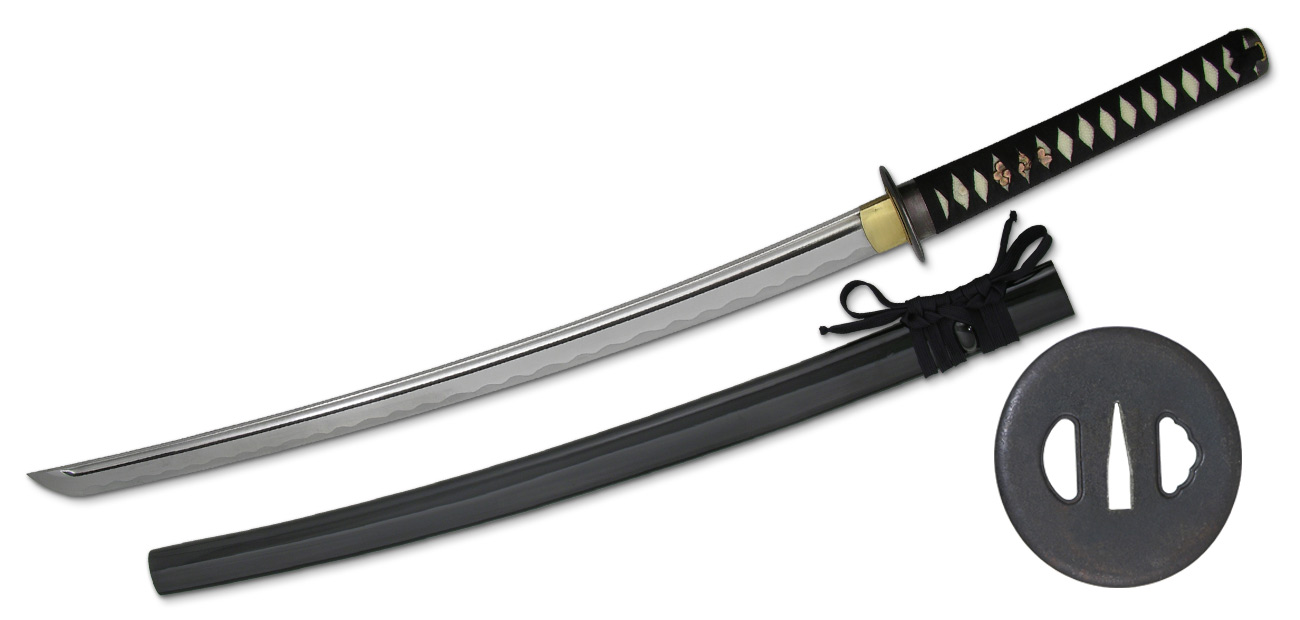
The XL is a relatively new type of Japanese sword very similar to the Hira Zukuri style, a historically rare form of Japanese Katana that is becoming increasingly common as a competition cutter due to its sleek blade profile and incredible mat cutting ability.
In this review, I will be taking a close look at this economical cutter and looking at the pros and cons of this particular type of Japanese sword, because its unique geometry makes it something of a specialized and highly precise tool that has some very interesting (and enjoyable) applications...

Hanwei Practical XL Light Katana Review
Review by SBG Editor in Chief, Paul Southren
|
Steel Weight Point of Balance Price Range |
1566 Carbon Steel 2lbs 8oz 4.72" from tsuba US$319-579 |
Open the box of the Hanwei Practical XL and straight away you notice that this is no ordinary Katana....
The width of the Saya is the first clue that the blade within is something very unique, as is the curvature of the sori.

It was curious that the sageo (rope of the saya/scabbard) was untied upon opening it, suggesting that this was not a sword you'd just stick on display but tie to your belt and bring to the dojo. And the more I inspected it, the more apparent this really is...
Fit and Finish
Like the rest of the Practical Katana in Hanwei's performance series, the fittings are nothing much aesthetically, and its obvious that this type of Japanese sword has a focus on function over form.
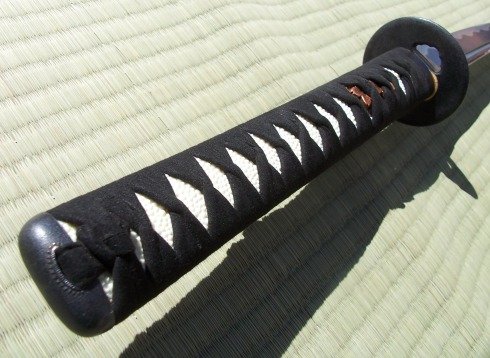
The 11" tsuka is covered in synthetic (plastic) rayskin and wrapped
with black suede. Not my two favorite combination I must admit, but that's standard for the Hanwei Practical line below any kind of 'Plus'.
The copper colored flower themed menuki certainly help to increase its overall attractiveness, and are the same (very popular) style that was used on the original Practical Katana series. Though, dare I say it, they are made of plastic..
Not great so far, but it looks ok.
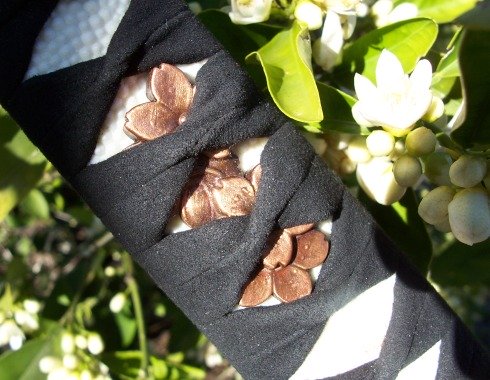
Ditto for the tsuba, which is also the plain round variety seen on the original PK, though the texture is more interesting when you take a look at it up close.
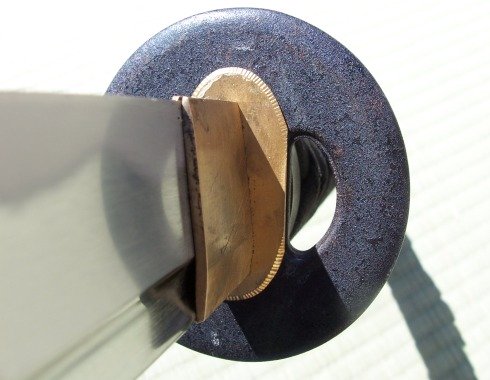
Overall, while I'm not thrilled about the plastic and stuff, it's put together well enough and I can overlook it because it can always be changed out later if the blade is any good. And it is..
The Blade
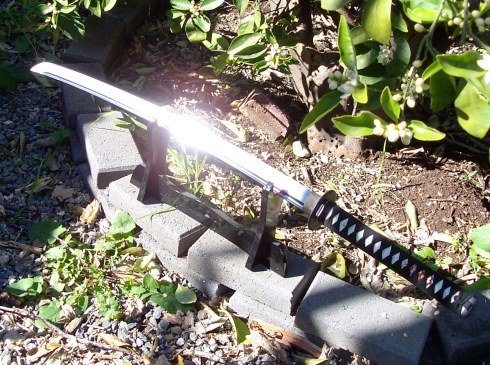
Now as I mentioned, the Practical XL Light Katana is a sword that is very similar to the Hira Zukuri style, in other words a type of Japanese sword that was historically very rare due to the rather poor quality of traditional Japanese steel (the only real difference is that it has yokote, or a ridge line just before the tip).
Anyway, this type of blade was quite common on tanto (knives) but the length of a Katana made it problematic unless every cut was done with perfect edge alignment and perfect form.
Of course, with the quality of modern steel being so much more predictable, this type of Japanese sword is seeing something of a Renaissance. Primarily because, the flat and wide blade is so good at cutting tatami mats and other light to medium targets that it is almost like cheating...
But also because, to put it mildly, these things are RIDICULOUSLY sharp. Their warning label product is sharp is deadly serious...
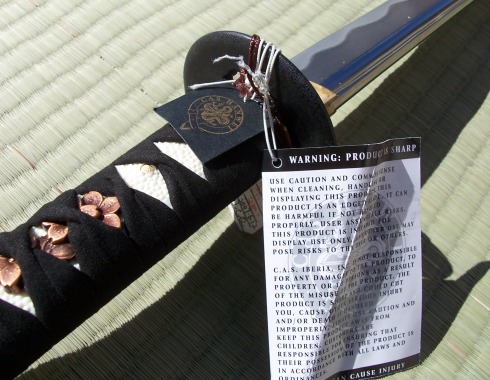
This thing is like a laser. Preliminary paper cutting tests show that each cut is extremely clean and sharp.
VIDEO: Paper Cutting
Cuts like a 3 foot long razor blade
Now the actual blade itself has a quite a high level of polish considering its price point and which really reveals the overall quality of the 1095 carbon steel. Like all the practical Katana series, the blade is also differentially hardened, though the hamon is acid etched over to give it the typical Hanwei frosted look.
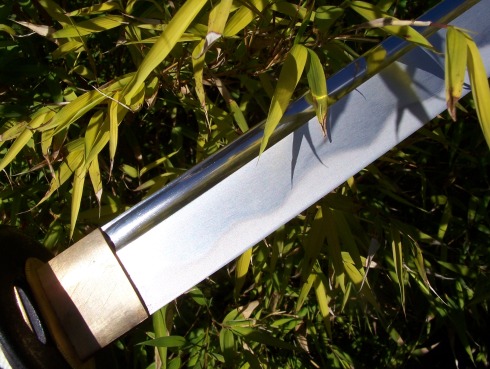
Some like it, others hate it but personally I dont think it matters much as this isn't a display or art sword - this type of Japanese sword is designed to be USED.
The kissaski (tip) is very cleanly finished and as sharp as the rest of the blade, allowing precise and deadly tip cuts, with boshi and yokote and is much better than most Katana in the same general price range.
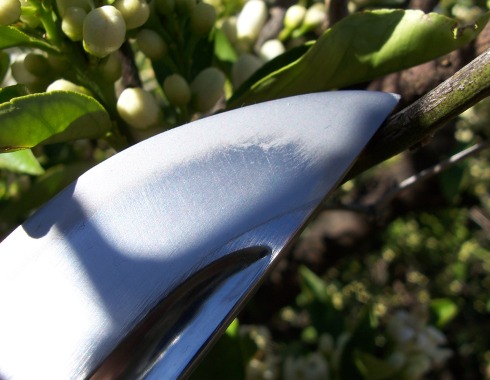
Overall, its an excellent and supremely sharp blade in bland but very functional fittings.
Handling
Weighing in at 2lbs 8oz and with a point of balance 4.72 inches from the tsuba, the Practical XL Light handles quite well considering its awesome blade dimensions. The bo-hi (fuller/blood groove) lightens the weight and shifts it back towards the hand, so it feels reasonably responsive considering the amount of steel present.
This type of Japanese sword may not the best handling sword I have ever used, but it's not the worst either - I would have to say that it feels somewhat 'neutral'.
However, when you put some targets in front of it the Practical XL Light comes alive...
Test Cutting
This type of Japanese sword is truly a precision tool when it comes to light cutting duties. With a razor sharp edge and wide blade profile, targets like water filled bottles are cleanly cut without effort, regardless of how many you want to put in front of it.
VIDEO: Cutting Water filled bottles
It should come as no surprise that cutting water bottles with this blade is a breeze
As such, it is the type of Japanese sword that's a backyard cutters dream. But it REALLY performs when you put the target that it was made for in front of it, tatami omote...
The blade slices tatami all by itself. All you need to do is make sure you cut it at the right angle and the geometry and sharpness takes care of the rest.
VIDEO: Cutting Tatami Mats
This blade was BORN to cut Tatami
To say that I was impressed by its mat cutting abilities is an understatement. It would have to be one of the top mat cutters around, out slicing blades several times its price and is definitely in the top 2 or 3 cutters in this price range.
However, with a very hard and relatively thin edge, I would not recommend it for usage on anything much harder than tatami. While the Cheness SGC Katana is also a Hira Zukuri sword the monosteel 9260 spring steel makes it several times more durable. In a direct comparison between these two swords, the XL Light cuts mats much better and with less effort, but simply doesn't have the kind of durability that the SGC has and hitting it against the cutting stand would likely be disastrous.
As such, the best way to describe it is as a precision tool. It is perfectly optimized to cut tatami (which of course, is a target used in the Japanese sword arts to simulate a human limb) and there is no doubt that it is deadly effective in this capacity. But it is very much a specialized instrument, and only recommended for usage within these strictly defined parameters.
This is certainly not a bad thing though. Because once you have cut some bottles or mats with it, you may have trouble going back to a normal Shinogi Zukuri geometry, that is for sure...
PROS
- Great geometry designed specifically to make short work of light targets and tatami mats
- Extremely (extremely) sharp blade
- Well assembled fittings
CONS
- Not very versatile and not durable - blade is a little on the fragile side and works best if used in a dojo setting (you do NOT want a fragment of the razor sharp sword flying)
- Fake and unattractive looking rayskin with synthetic suede ito and plastic bits are not very eye pleasing
WHERE TO BUY
If you know where to look, you can pick these swords up for a pretty decent price. My recommendation is here at Kult of Athena, where it is $319.20, much better than just about anywhere else and considerably less than the $579 MSRP!!
I hope this review of this Practical XL Light Katana has been helpful. To return to A Beginners Guide to Authentic Japanese Swords from A type of Japanese sword for cutting Tatami the Practical XL Light Katana Reviewed, click here














